See Ching Mey, Melissa Ng Lee Yen Abdullah, Chuah Joe Yin
Research universities in Malaysia are striving to transform into world-class institutions. These universities have the capacity to attract the best students to achieve excellence in education and research. It is important to monitor the psychological well-being of students during the transformation process so that proactive intervention can help students cope with the learning and research demands. This study profiled and monitored the personality traits of postgraduate and undergraduate students in a selected Malaysian research university using a quantitative research method. The researchers profiled personality traits using an online assessment, the Behavioral Management Information System (BeMIS), and tracked real and preferred personality traits and positive changes during rapid institutional transition.
Keywords: personality traits, BeMIS, undergraduate students, research universities, psychological well-being
Malaysia is advancing toward a knowledge-based economy and relies heavily on its universities to educate and train the much-needed human capital for the country (Fernandez, 2010). Research universities have the capacity to attract the best students and have the autonomy to select students who excel in education and research. Various measures are being implemented to transform universities into world-class institutions (Wan, 2008). The institutional transformation at Malaysian universities focuses on critical areas such as governance, leadership, academia, teaching and learning, as well as research and development (Ministry of Higher Education, 2011). Educational institutions must monitor the psychological profile and well-being of their students, especially those who are potentially at risk of mental health issues such as anxiety and depression, as well as substance abuse, in order to promote optimum human capital development (Wynaden, Wichmann, & Murray, 2013). Moreover, during the institutional transformation process, all levels of the university community, including students, may experience changes driven by higher standards and demands in teaching and learning as well as research performance (Schraeder, Swamidass, & Morrison, 2006) that might result in stress (Becker et al., 2004; Gladstone & Reynolds, 1997; Smollan & Sayers, 2009). Certain personality traits may build the community’s resilience in coping with psychological stress (Lievens, Ones, & Dilchert, 2009; Nelson, Cooper, & Jackson, 1995). A detailed personality profile of university students can help research institutions put in place necessary support systems to strengthen students’ well-being during institutional transformation.
The Impact of Institutional Transformation
Institutional transformation at research universities in Malaysia can result in stress, anxiety and uncertainty for students at both undergraduate and postgraduate levels. Successful coping with new demands is integral to the process of transformation. Failure to cope with stressors may lead to fatigue and depressive mood. Such physical and psychological symptoms may impair daily living, work and school performance, and learning ability (Goretti, Portaccio, Zipoli, Razzolini, & Amato, 2010; See, Abdullah, Teoh, & Yaacob, 2011). Organizational change may affect personality changes in students and impact academic performance (Horng, Hu, Hong, & Lin, 2011; Nelson et al., 1995; Oreg & Sverdlik, 2011; See et al., 2011). Ongoing research including profiling and monitoring the personality traits and psychosocial behavior of students can assist students in adapting successfully (Marshall, 2010). Counselors and psychologists at the university can help students develop positive coping strategies during stressful transitional periods.
Personality Characteristics
Connor-Smith and Flachsbart (2007) have defined personality as characteristic patterns of thoughts, feelings and behaviors over time and across situations. Some theorists have described coping as a process of the personality responding to stress (Connor-Smith & Flachsbart, 2007). For example, individuals with the personality trait of extraversion may seek social support during life crisis, while someone with the trait of neuroticism may respond with avoidance or denial. Thus, personality traits may influence university students’ responses and coping skills in stressful situations. Individuals with an extraverted personality tend toward optimistic assessment of accessible coping resources and react less intensely to stress, while those with a neurotic personality often experience high rates of stress and intense emotional and physiological reactivity to stress (Connor-Smith & Flachsbart, 2007). Personality predispositions can predict an individual’s ability to adapt to change. Resilient traits enable stress management in reaction to institutional transformation (Nelson et al., 1995; Oreg, Vakola, & Armenakis, 2011; See et al., 2011). The goal of this study was to analyze the personality profile of undergraduate and postgraduate students at a research university in Malaysia during institutional transformation, and to propose proactive interventions to help the student community cope with change.
Overview of the Study
The selected research university in this study was awarded the status of Accelerated Program for Excellence (APEX) in 2008, making it the first and only APEX university in Malaysia. APEX is a fast-track development program that aims to enable a selected university to transform and seek world-class status (Razak, 2009). The APEX program has been identified as a critical initiative to increase the level of excellence of higher education in Malaysia (Razak, 2009). An APEX university has the autonomy to select students based on academic merit and other criteria that the university deems essential. For this study, the researchers randomly selected from among postgraduate and undergraduate students who had volunteered to participate, and used the Behavioral Management Information System (BeMIS) to investigate the students’ personality profile and well-being. The research objectives included the following: (a) profile the real and preferred personality traits of the university students during institutional transformation, and (b) explore personality changes over different phases during the university’s transitional period.
Participants and Design
This longitudinal study gathered data relating to personality traits and psychosocial behaviors of postgraduate and undergraduate students over three phases. Seventy-eight students (34 undergraduate students and 44 postgraduate students) participated in phase 1; 142 students (80 undergraduate students and 62 postgraduate students) participated in phase 2; and 169 students (72 undergraduate students and 97 postgraduate students) participated in phase 3.
Instrument
The BeMIS is an online assessment and reporting tool used to measure personality. The BeMIS was developed using the Adjective Check List (ACL), a standardized personality trait measure comprised of 300 adjectives commonly used to describe personality traits (Gough & Heilbrun, 1983). The ACL is capable of effectively measuring 37 personality traits under five main categories of traits: (a) responsiveness, (b) psychological needs, (c) specific responses, (d) interpersonal behavior and (e) cognitive orientation (Gough & Heilbrun, n.d.; Center for Credentialing and Education, 2009). The 37 personality traits are enthusiasm, optimism, negativity, communality, achievement, dominance, endurance, order, exhibition, psychologically perceptive, nurturance, affiliation, social energy, autonomy, aggression, change, support seeking, self-blaming, deference, counseling readiness, self-control, self-confidence, personal adjustment, self-satisfaction, creativity, structure valuing, masculinity, femininity, fault finding, respectful, work centered, playful, security seeking, affected, intellectualistic, pragmatic and scientific. The behavior for each scale is presented in percentile ranks, and grouped into real and preferred personality traits. The real-self personality traits are the existing traits, and the preferred-self traits are the desired traits. The mean for each measured behavior is 50, with a standard deviation of 10. On average, scores range between 40 and 60. A score of 60 is considered high and indicates a strong expression of the trait. A score of less than 40 is considered low and suggests suppression of the trait. Any extreme score (exceeding 70 or less than 30) may reveal stress and dissatisfaction with life (Gough & Heilbrun, n.d.). The BeMIS was translated into Bahasa Malaysia and the reliability of the Bahasa Malaysia version was tested (See et al., 2011). The reliability and validity of the BeMIS and ACL have been adequately substantiated (See et al., 2011; Center for Credentialing and Education, 2009; Gough & Heilbrun, n.d.).
Procedure
The researchers conducted the first phase of the study 1 year after the start of the university transformation process. They carried out phase 2 of the study 18 months after the university embarked on the transformation agenda, and carried out the third phase two and a half years after the start of the transformation process. The researchers sent questionnaires to all 26 schools in the university, requesting for each school to randomly select five postgraduate students and five undergraduate students to participate in the study. Participants were required to respond to BeMIS twice during each phase. The first time participants chose adjectives that they thought described them as they really were, while the second time they chose adjectives that they would prefer to describe them. In addition to the questionnaire, participants received a participant information and consent form that served to protect the confidentiality of student information.
Results
Postgraduate Students’ Personality Profile
Figure 1 shows the real-self and the preferred-self traits of the postgraduate students in phase 1 of the study. The postgraduate students did not indicate any extreme low scores (less than 30) or extreme high scores (more than 70) during this phase of the study. The researchers performed a t test, and found significant differences (p < 0.05) in 17 of the 37 traits between the real self and the preferred self of postgraduate students. Among these 17 traits, four traits were significantly higher in the real self, compared to the preferred self: negativity, support seeking, self-blaming and security seeking. In contrast, 13 traits were significantly higher in the preferred self than the real self (optimism, achievement, dominance, endurance, order, affiliation, self-confidence, personal adjustment, self-satisfaction, structure valuing, masculinity, respectful and work centered), indicating that the postgraduate students desired to be stronger in these traits.
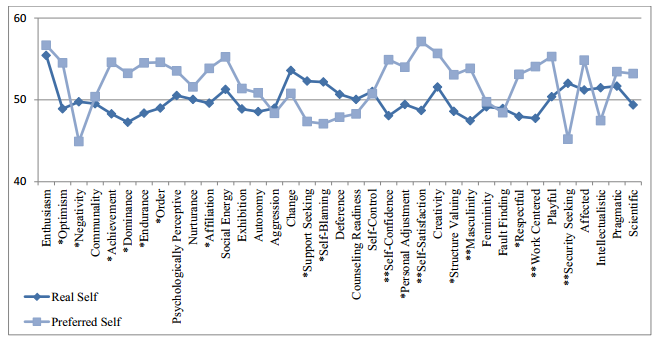
Figure 1. Postgraduate students’ personality traits (real/preferred) in phase 1.* p < 0.05. ** p < 0.01.
The real-self and the preferred-self traits of the postgraduate students in phase 2 of the study appear in Figure 2. The postgraduate students did not indicate any extreme low scores (less than 30) or extreme high scores (more than 70) during this phase of the study. The researchers found 24 traits to be significantly different (p < 0.05) between the real self and the preferred self of postgraduate students. Among the 24 traits, the researchers found five traits to be significantly higher in the real self than the preferred self: negativity, support seeking, self-blaming, security seeking and intellectualistic. The researchers found 19 of the 24 traits to be significantly higher in the preferred self than the real self (optimistic, achievement, dominance, endurance, order, psychologically perceptive, affiliation, exhibition, self-confidence, personal adjustment, self-satisfaction, creativity, structure valuing, masculinity, respectful, work centered, playful, affected, and scientific), indicating that the postgraduate students desired to be stronger in these traits.
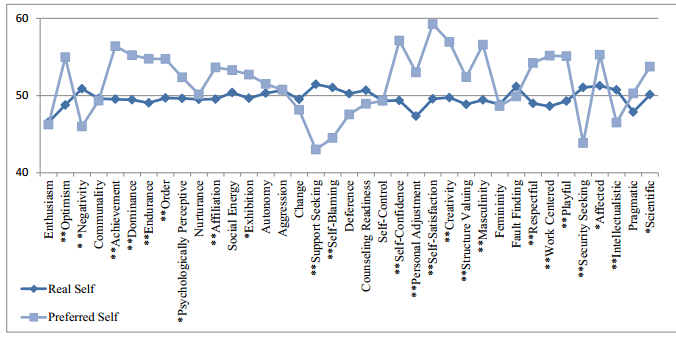
Figure 2. Postgraduate students’ personality traits (real/preferred) in phase 2. * p < 0.05. ** p < 0.01.
In phase 3, as revealed in Figure 3, the institutional transformation produced strong preferred-self traits (scores of more than 60), including optimism, self-satisfaction, creativity, playful, self-confidence and dominance. The postgraduate students indicated scores below 40 for two preferred-self traits—support seeking and security seeking—indicating a suppression of the traits. The postgraduate students did not indicate any extreme low scores (less than 30) or extreme high scores (more than 70) for either the real-self or the preferred-self traits in phase 3. The incongruence between the real-self and the preferred-self traits was most exaggerated in phase 3 (Figure 3), in which the researchers found 25 traits to be significantly different (p < 0.05). The five traits found to be significantly higher in the real self were the same as in phase 2 (negativity, support seeking, self-blaming, security seeking and intellectualistic). The 20 traits found to be significantly higher in the preferred self were similar to the ones in phase 2 (optimistic, achievement, dominance, endurance, order, psychologically perceptive, affiliation, exhibition, self-confidence, personal adjustment, self-satisfaction, creativity, structure valuing, masculinity, respectful, work centered, playful, affected and scientific), with the addition of the nurturance trait.
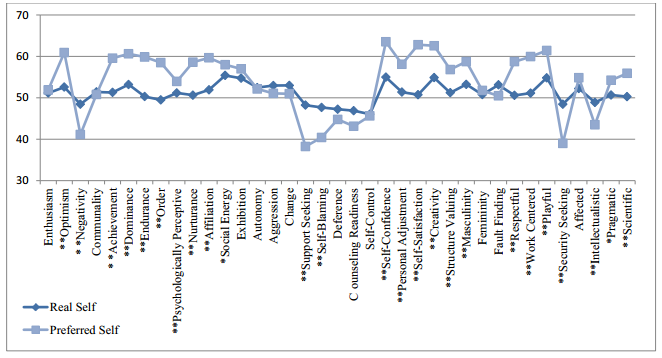
Figure 3. Postgraduate students’ personality traits (real/preferred) in phase 3. * p < 0.05. ** p < 0.01.
Undergraduate Students’ Personality Profile
The real-self and the preferred-self traits of undergraduate students in phase 1 of the study appear in Figure 4. The undergraduate students did not indicate any extreme low scores (less than 30) or extreme high scores (more than 70) during the first phase of the study. The researchers performed a t test on the real-self and the preferred-self traits of the undergraduate students and found significant differences (p < 0.05). In phase 1, 26 traits of the real self and the preferred self of the undergraduate students had significant differences. Six traits—negativity, support seeking, self-blaming, fault finding, security seeking and intellectualistic—were found to be significantly higher in the real self compared to the preferred self. The other 20 traits were significantly higher in the preferred self than the real self, indicating that the undergraduate students desired to be stronger in the following 20 traits: optimistic, achievement, dominance, endurance, order, psychologically perceptive, nurturance, affiliation, social energy, aggression, self-confidence, personal adjustment, self-satisfaction, creativity, structure valuing, masculinity, respectful, work centered, playful and scientific.
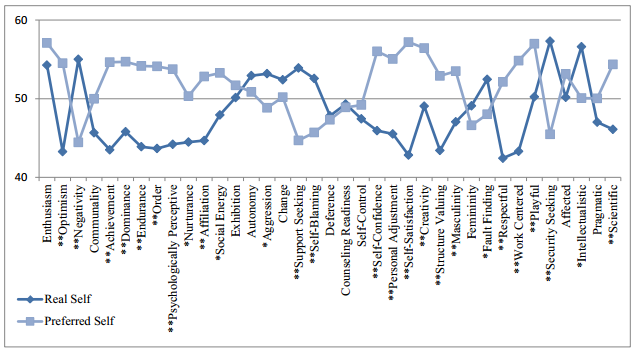
Figure 4. Undergraduate students’ personality traits (real/preferred) in phase 1. * p < 0.05. ** p < 0.01.
Figure 5 shows the real-self and the preferred-self personality traits of the undergraduate students in phase 2. The undergraduate students did not indicate any extreme low scores (less than 30) or extreme high scores (more than 70) in phase 2. In this phase, the researchers found 27 traits to be significantly different (p < 0.05) between the real self and the preferred self. Five of the 27 traits (negativity, support seeking, self-blaming, security seeking and intellectualistic) were found to be significantly higher in the real self than the preferred self. The following 22 of the 27 traits were found to be significantly higher in the preferred self than the real self: optimistic, achievement, dominance, endurance, order, psychologically perceptive, nurturance, affiliation, social energy, exhibition, self-confidence, personal adjustment, self-satisfaction, creativity, structure valuing, masculinity, respectful, work centered, playful, affected, pragmatic and scientific.
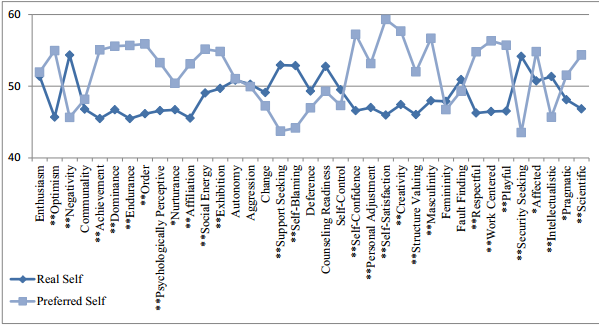
Figure 5. Undergraduate students’ personality traits (real/preferred) in phase 2. * p < 0.05. ** p < 0.01.
As found in the real self and the preferred self of the postgraduate students, the incongruence in personality traits of the undergraduate students was most obvious in phase 3. Figure 6 exhibits eight strong preferred-self traits (scores of more than 60) including optimism, achievement, dominance, self-confidence, self-satisfaction, creativity, work centered and playful. In contrast, the undergraduate students indicated scores below 40 for two preferred-self traits—support seeking and security seeking—indicating a suppression of the traits. The undergraduate students did not indicate any extreme low scores (less than 30) or extreme high scores (more than 70) in either the real-self or the preferred-self traits in phase 3. The researchers found 26 traits to be significantly different (p < 0.05). The five traits that were found to be significantly higher in the real self were the same as in phase 2 (negativity, support seeking, self-blaming, security seeking and intellectualistic). Twenty-one traits were found to be significantly higher in the preferred self: optimistic, achievement, dominance, endurance, order, psychologically perceptive, nurturance, affiliation, social energy, exhibition, self-confidence, personal adjustment, self-satisfaction, creativity, structure valuing, masculinity, respectful, work centered, playful, affected and scientific.
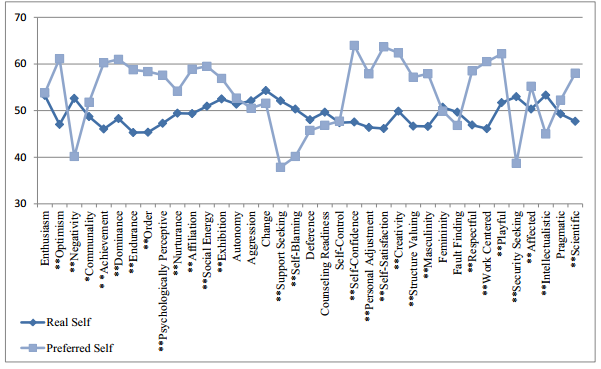
Figure 6. Undergraduate students’ personality traits (real/preferred) in phase 3. * p < 0.05. ** p < 0.01.
Personality Changes over Phases of the Transitional Period
Real-self personality traits. Postgraduate and undergraduate students did not exhibit extreme real-self personality traits (scores of less than 30 or more than 70) throughout the process of the university’s transformation. The researchers performed nonparametric tests to examine changes within the real-self traits of the postgraduate and undergraduate students throughout the three phases of the study (see Figures 8 and 9). As shown in Figures 7 and 8, the researchers found more significant changes within the real-self traits of the postgraduate students compared to those of the undergraduate students. Sixteen real-self traits of the postgraduate students experienced significant changes over the three phases. Among the 16 real-self traits, eight traits (optimism, dominance, social energy, exhibition, self-confidence, structure valuing, masculinity and work centered) increased significantly over the three phases, while two traits (support seeking and self-blaming) decreased significantly over the three phases. Five traits decreased in phase 2, but increased significantly again in phase 3: enthusiasm, change, personal adjustment, creativity and playful. The negativity trait increased during phase 2 but decreased in phase 3. Despite the significant fluctuation of the postgraduate students’ traits, in general, positive traits increased while negative traits decreased. Conversely, the real-self traits of undergraduate students appeared more stable compared to the real-self traits of the postgraduate students (Figure 8). Four real-self traits of undergraduate students experienced significant changes: nurturance, affiliation, playful and intellectualistic. The nurturance and affiliation traits increased significantly over the three phases, whereas the playful and intellectualistic traits decreased significantly during phase 2, but increased again in phase 3.
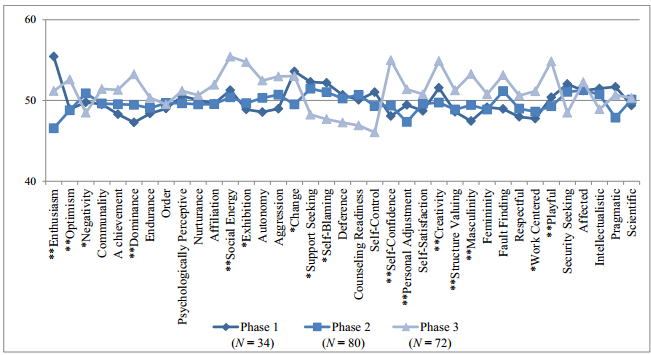
Figure 7. Changes in postgraduate students’ real-self personality traits across phases 1, 2 and 3.* p < 0.05. ** p < 0.01.
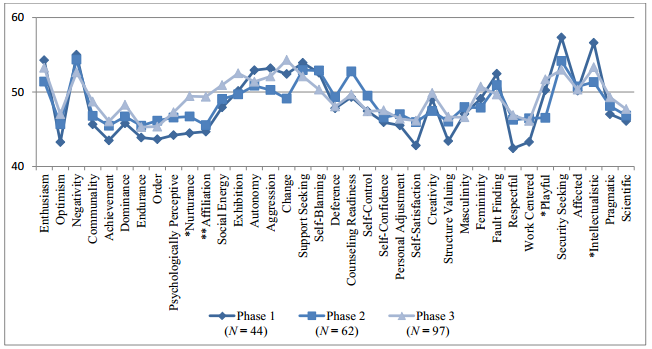
Figure 8. Changes in undergraduate students’ real-self personality traits across phases 1, 2 and 3.* p < 0.05. ** p < 0.01.
Preferred-self personality traits. As seen in Figures 9 and 10, the preferred-self personality traits of postgraduate and undergraduate students did not fluctuate radically throughout the three phases of the study. However, a greater number of the preferred-self traits of the postgraduate and undergraduate students experienced significant changes than the number of their real-self traits. Figure 9 depicts the comparison of the postgraduate students’ preferred-self traits across the three phases. The result of the nonparametric test showed that 27 of the preferred-self traits of the postgraduate students experienced significant changes over the three phases. Among the 27 traits, 13 traits significantly increased over the three phases (optimism, achievement, dominance, endurance, order, social energy, exhibition, self-confidence, self-satisfaction, creativity, masculinity, respectful and work centered), indicating students’ desire to be stronger in these traits. Four preferred traits (support seeking, self-blaming, self-control and security seeking) decreased significantly over the three phases. The constant decreases in support seeking and self-control indicate that postgraduate students prefer not to seek advice and emotional support and prefer to be less self-controlled and restrained, and the university ought to pay attention to this finding. In addition, eight preferred-self traits (enthusiasm, psychologically perceptive, nurturance, affiliation, personal adjustment, structure valuing, playful and pragmatic) decreased during phase 2, but increased again in phase 3; two preferred-self traits (negativity and counseling readiness) increased during phase 2, but dropped significantly in phase 3. The drop in counseling readiness in phase 3, which is congruent with the constant decrease in support seeking, requires attention from the university, because this finding indicates that the postgraduate students prefer not to accept counseling or professional advice to help them cope with their personal problems and psychological difficulties.
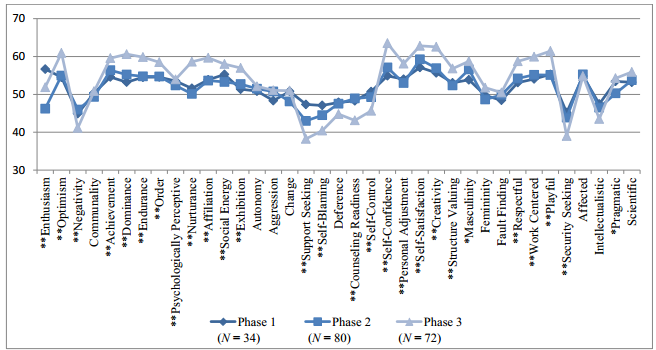
Figure 9. Changes in postgraduate students’ preferred-self personality traits across phases 1, 2 and 3.
* p < 0.05. ** p < 0.01.
As for undergraduate students, 27 preferred-self traits experienced significant changes over the three phases of the study. Fourteen preferred-self traits increased significantly over the three phases of the study: optimism, achievement, dominance, endurance, order, nurturance, affiliation, social energy, exhibition, self-confidence, self-satisfaction, creativity, respectful and work centered, indicating that undergraduate students had a constant desire to be stronger in these traits. On the other hand, four preferred-self traits decreased over the three phases: support seeking, self-blaming, security seeking and intellectualistic. As mentioned before, the constant decrease in support seeking is concerning because it indicates that students prefer not to seek support and advice when they encounter problems or issues. Undergraduate students showed less desire to be more intellectualistic, suggesting that they prefer not to emphasize versatility, unconventionality and individuality. In addition, eight preferred-self traits decreased during phase 2, but increased again in phase 3 (enthusiasm, communality, psychologically perceptive, change, personal adjustment, structure valuing, playful and scientific), while the negativity trait increased during phase 2 but decreased again in phase 3.
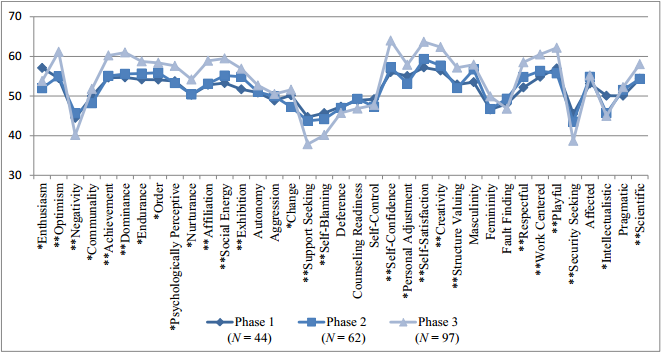
Figure 10. Changes in undergraduate students’ preferred-self personality traits across phases 1, 2 and 3.
* p < 0.05. ** p < 0.01.
Clearly, postgraduate and undergraduate students shared similar trends in their preferred-self traits (Figures 9 and 10). Both the postgraduate and undergraduate students recorded constant increases in the same 12 preferred traits (optimism, achievement, dominance, endurance, order, social energy, exhibition, self-confidence, self-satisfaction, creativity, respectful and work centered) and constant decreases in three of the preferred-self traits (support seeking, self-blaming and security seeking).
Discussion
Findings on the personality profile of undergraduate and postgraduate students at this research university in Malaysia are promising. The results suggest that students are coping well with the institutional transformation. In fact, personality traits such as optimism, endurance, dominance, order, exhibition, self-confidence and creativity were highly expressed and developed, as profiled in phase 3 of the study. These highly expressed and developed traits indicate that students are dignified, flexible, hopeful and unyielding in their desire to excel. They also value cognitive activity and insight. However, their profile shows some concerns in traits such as support seeking and security seeking, which dropped continuously during the study. Such findings suggest that students may not be ready for counseling and prefer not to seek help and support when they encounter problems.
Because change in an organization may cause strain and uncertainty (Nelson et al., 1995), Marshall (2010) proposed that early assessment and intervention be implemented accordingly. Assessment of students’ perceptions of the transformation initiatives, particularly on teaching, learning and research activities, would help to evaluate the impact of institutional transformation on the psychological well-being of the students (Loretto, Platt, & Popham, 2010). Preparing and guiding students through the transformation process helps them to adapt and thrive (Marshall, 2010; Tosevski, Milovancevic, & Gajic, 2010). Loretto et al. (2010) found that preparation for change and timely training with open communication may build trust and minimize uncertainty by increasing control.
Gradual and orderly structural policy changes may facilitate adjustment and minimize needless stressors. Secrecy and poor communication may result in poor morale and low self-satisfaction (Becker et al., 2004; Nelson et al., 1995; Smollan & Sayers, 2009). In contrast, promoting transparency and coordination in the learning environment may encourage attitudes of independence, objectivity, industriousness, respectfulness, confidence, assertiveness, initiative and enthusiasm. These interventions may help ensure the mental well-being of students, which in turn affects their academic achievement positively and contributes toward the success of the university transformation process. Tosevski et al. (2010) have suggested building trust in instructor-student relationships to promote autonomy and clarify role expectations. Practicing a student-driven learning approach may inspire creativity and leadership, bringing forth greater self-satisfaction among students.
As the university moves toward becoming a world-class institution, students fit themselves into the vision and mission of the university. In this study, the differences between the real-self and the preferred-self traits were most exaggerated in the third phase. When the preferred-self traits are much higher than the real-self traits, students may feel frustrated. According to Rogers (2007), incongruence between real and preferred value in personality traits may increase one’s vulnerability to stress or anxiety. Mild anxiety brings forth self-awareness in response to the incongruence in personality and may result in therapeutic change and the learning of new coping skills (Rogers, 2007). The university can provide counseling services to assist those students who need help.
Conclusion
The APEX initiative is transforming the selected research university to embrace excellence, innovation and dynamism in moving toward the goal of becoming a world-class institution. The results of this study suggest that university students are coping well with the institutional transformation. In fact, many desired personality traits became more strongly expressed and developed during the transformation phases. It is crucial to continually monitor the personality profile and psychological well-being of students. The institution also can implement proactive interventions to support the mental health and development of human capital in all students.
References
Becker, L. R., Beukes, L. D., Botha, A., Botha, A. C., Botha, J. J., Botha, M., . . .Vorster, A. (2004). The impact of university incorporation on college lecturers. Higher Education, 48, 153–172.
Center for Credentialing and Education. (2009). The BeMIS Personality Report for Sample Client. Greensboro, NC: Author.
Connor-Smith, J. K., & Flachsbart, C. (2007). Relations between personality and coping: A meta-analysis. Journal of Personality and Social Psychology, 93, 1080–1107. doi:10.1037/0022-3514.93.6.1080
Fernandez, J. L. (2010). An exploratory study of factors influencing the decision of students to study at Universiti Sains Malaysia. Kajian Malaysia, 28(2), 107–136.
Gladstone, J., & Reynolds, T. (1997). Single session group work intervention in response to employee stress during workforce transformation. Social Work With Groups, 20, 33–49. doi:10.1300/J009v20n01_04
Goretti, B., Portaccio, E., Zipoli, V., Razzolini, L., & Amato, M. P. (2010). Coping strategies, cognitive impairment, psychological variables and their relationship with quality of life in multiple sclerosis. Neurological Sciences, 31(Suppl. 2), S227–S230.
Gough, H. G., & Heilbrun, A. B., Jr. (n.d.). Assess psychological traits with a full sphere of descriptive adjectives. Retrieved from http://www.mindgarden.com/products/figures/aclresearch.htm
Gough, H. G., & Heilbrun, A. B., Jr. (1983). The Adjective Check List manual (2nd ed.). Palo Alto, CA: Consulting Psychologists Press.
Horng, J., Hu, M., Hong, J., & Lin, Y. (2011). Innovation strategies for organizational change in a tea restaurant culture: A social behavior perspective. Social Behavior and Personality, 39, 265–273. doi:10.2224/sbp.2011.39.2.265
Lievens, F., Ones, D. S., & Dilchert, S. (2009). Personality scale validities increase throughout medical school. Journal of Applied Psychology, 94, 1514–1535. doi:10.1037/a0016137
Loretto, W., Platt, S., & Popham, F. (2010). Workplace change and employee mental health: Results from a longitudinal study. British Journal of Management, 21, 526–540. doi:10.1111/j.1467-8551.2009.00658.x
Marshall, S. (2010). Change, technology and higher education: Are universities capable of organisational change? ALT-J, Research in Learning Technology, 18, 179–192. doi:10.1080/09687769.2010.529107
Ministry of Higher Education. (2011). The National Higher Education Action Plan, Phase 2 (2011–2015). Retrieved from http://www.mohe.gov.my/transformasi/fasa2/psptn2-eng.pdf
Nelson, A., Cooper, C. L., & Jackson, P. R. (1995). Uncertainty amidst change: The impact of privatization on employee job satisfaction and well-being. Journal of Occupational and Organizational Psychology, 68, 57–71. doi:10.1111/j.2044-8325.1995.tb00688.x
Oreg, S., & Sverdlik, N. (2011). Ambivalence toward imposed change: The conflict between dispositional resistance to change and the orientation toward the change agent. Journal of Applied Psychology, 96, 337–349. doi:10.1037/a0021100
Oreg, S., Vakola, M., & Armenakis, A. (2011). Change recipients’ reactions to organizational change: A 60-year review of quantitative studies. The Journal of Applied Behavioral Science, 47, 461–524. doi:10.1177/0021886310396550
Razak, D. A. (2009). In search of a world-class university of tomorrow: The importance of the APEX initiative. Kuala Lumpur, Malaysia: Oxford Fajar.
Rogers, C. R. (2007). The necessary and sufficient conditions of therapeutic personality change. Psychotherapy: Theory, Research, Practice, Training, 44, 240–248. doi:10.1037/0033-3204.44.3.240
Schraeder, M., Swamidass, P. M., & Morrison, R. (2006). Employee involvement, attitudes and reactions to technology changes. Journal of Leadership & Organizational Studies, 12, 85–100. doi:10.1177/107179190601200306
See, C. M., Abdullah, M. N. L. Y., Teoh, B. S. G., & Yaacob, N. R. N. (2011). Profiles of an Accelerated Programme for Excellence (APEX) university community: Personality traits and psychosocial behavior. Monograph Series of USM, 14, 1–88.
Smollan, R. K., & Sayers, J. G. (2009). Organizational culture, change and emotions: A qualitative study. Journal of Change Management, 9, 435–457. doi:10.1080/14697010903360632
Tosevski, D. L., Milovancevic, M. P., & Gajic, S. D. (2010). Personality and psychopathology of university students. Current Opinion in Psychiatry, 23, 48–52. doi:10.1097/YCO.0b013e328333d625
Wan, A. M. W. M. (2008). The Malaysian National Higher Education Action Plan: Redefining autonomy and academic freedom under the APEX experiment. Paper presented at the Asaihl Conference, University Autonomy: Interpretation and Variation, Universiti Sains Malaysia, Penang, Malaysia.
Wynaden, D., Wichmann, H., & Murray, S. (2013). A synopsis of the mental health concerns of university students: Results of a text-based online survey from one Australian university. Higher Education Research & Development, 32, 840–860. doi:10.1080/07294360.2013.777032
See Ching Mey is Deputy Vice-Chancellor of the Division of Industry and Community Network at the Universiti Sains Malaysia. Melissa Ng Lee Yen Abdullah is a senior lecturer in the School of Educational Studies at the Universiti Sains Malaysia. Chuah Joe Yin is the assistant registrar in the Division of Industry and Community Network at the Universiti Sains Malaysia. Correspondence can be addressed to See Ching Mey, Division of Industry and Community Network, 6th Floor, Chancellory Building, Universiti Sains Malaysia, 11800, Penang, Malaysia, cmsee@usm.my.
